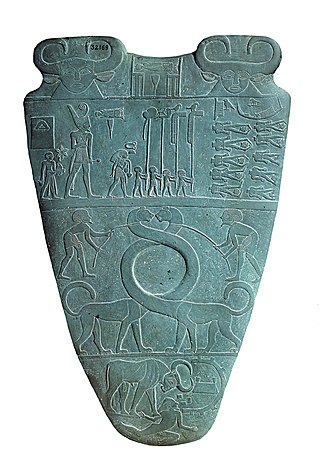Naqada III
Last phase of the Naqada culture of ancient Egyptian prehistory From Wikipedia, the free encyclopedia
Naqada III is the last phase of the Naqada culture of ancient Egyptian prehistory, dating from approximately 3200 to 3000 BC.[2] It is the period during which the process of state formation, which began in Naqada II, became highly visible, with named kings heading powerful polities. Naqada III is often referred to as Dynasty 0 or the Protodynastic Period[2] to reflect the presence of kings at the head of influential states, although, in fact, the kings involved would not have been a part of a dynasty. In this period, those kings' names were inscribed in the form of serekhs on a variety of surfaces including pottery and tombs.
| Geographical range | Egypt |
|---|---|
| Period | Early Bronze I |
| Dates | c. 3,300 BC – 2,900 BC[1] |
| Major sites | Naqada, Tarkhan, Nekhen |
| Preceded by | Naqada II, Maadi culture |
| Followed by | First Dynasty of Egypt |

History
Summarize
Perspective
The Protodynastic Period in ancient Egypt was characterised by an ongoing process of political unification, culminating in the formation of a single state to begin the Early Dynastic Period. Furthermore, it is during this time that the Egyptian language was first recorded in hieroglyphs. There is also strong archaeological evidence of Egyptian settlements in southern Canaan during the Protodynastic Period, which are regarded as colonies or trading entrepôts.
Archaeologists Pierre de Miroschedji and Moain Sadeq hypothesise that the Egyptian activity in the Levant of this period can be classified in three parts: an area of permanent settlement including Tell es-Sakan (which may have been the administrative centre) and En Besor; an area extending north along the coast of seasonal habitation, and beyond this to the east and further north was an area of interaction between the Egyptians and the Canaanites.[3]
State formation began during this era and perhaps even earlier. Various small city-states arose along the Nile. Centuries of conquest then reduced Upper Egypt to three major states: Thinis, Naqada, and Nekhen. Sandwiched between Thinis and Nekhen, Naqada was the first to fall. Thinis then conquered Lower Egypt. Nekhen's relationship with Thinis is uncertain, but these two states may have merged peacefully, with the Thinite royal family ruling all of Egypt. The Thinite kings were buried at Abydos in the Umm el-Qa'ab cemetery.[citation needed]
Early Egyptologists such as Flinders Petrie were proponents of the Dynastic race theory which hypothesised that the first Egyptian chieftains and rulers were themselves of Mesopotamian origin,[4] but this view has been abandoned among modern scholars.[5][6][7][8][9]
Most Egyptologists consider Narmer to be both the last king of this period and the first king of the First Dynasty. He was possibly preceded over some parts of Upper Egypt by Crocodile, Iry-Hor, Ka, and perhaps by the king Scorpion II, whose name may refer to, or be derived from, the goddess Serket, a special early protector of other deities and the rulers.[10]
Naqada III extended all over Egypt and was characterized by some notable firsts:
- The first hieroglyphs
- The first graphical narratives on palettes
- The first regular use of serekhs
- Possibly the first example of irrigation
And at best, a notable second:
- The invention of sail navigation[11] (derived from its prior invention in the Persian Gulf 2,000 years earlier)[12]
According to the Egypt's Ministry of Antiquities, in February, 2020, Egyptian archaeologists have uncovered 83 tombs dating back to 3,000 B.C, known as the Naqada III period. Various small ceramic pots in different shapes and some sea shells, makeup tools, eyeliner pots, and jewels were also revealed in the burial.[13][14]
Decorative cosmetic palettes
Many notable decorative palettes are dated to Naqada III, such as the Hunters Palette.
- Hunters Palette, circa 3100 BC
- "Four Dogs Palette" (3300–3100 BC)
- Fragment of a ceremonial palette illustrating a man and a type of staff, ca. 3200–3100 BC
- Duck-shaped palette
- Bull Palette, 3100 BC
- The Battlefield Palette, possibly showing the subjection of the people of the Buto-Maadi culture, by the Egyptian rulers of Naqada III, circa 3100 BC.[15]
- Fragment of a palette, 3200–2800 BC.
Other artifacts
- Baboon Divinity bearing name of Pharaoh Narmer on base
- Protodynastic sceptre fragment with royal couple. Staatliche Sammlung für Ägyptische Kunst, Munich
- Hair Comb Decorated with Rows of Wild Animals 3200–3100 BCE, Naqada III
- Naqada III vessel
- Typical Naqada III cylindrical jar
See also
References
Further reading
External links
Wikiwand - on
Seamless Wikipedia browsing. On steroids.















